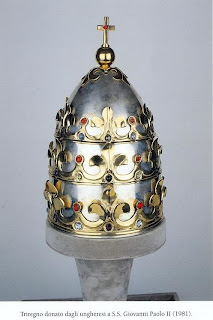And why do you worry about clothes? See how the lilies of the field grow. They do not labor or spin. Yet I tell you that not even Solomon in all his splendor was dressed like one of these. - Matthew 6:28-29
Today I came upon mention of
The Philippi Collection ....
a private collection [with] more than 500 head coverings gathered from Christianity, Islam, Judaism, Caodaism, Shinto, Buddhism, Sikhism, Free Churches, Sufism, Anabaptism and further communities of faith. Moreover that, the collection contains more than 100 pieces of accessories used for clerical and ecclesiastic purposes. Among these are shoes of the Pope, pontificial gloves, pallia, pectoral crosses, rings of bishops, pieces of the papal china, sashes, scarves of cardinals ... pectoral cross-cords ...
- a pair of B16's loafers in The Philippi Collection
The collection's even got
papal shoes, though apparently not
papal slippers or
episcopal sandals (don't even ask about the liturgical silk stockings). Wikipedia states of the
papal shoes ...
Pope Paul VI ... completely discontinued the custom of kissing the papal foot ... In 1969, Paul VI abolished buckles from all ecclesiastical shoes, which had been customarily required at the Papal Court and for prelates. He also discontinued the use of the indoor velvet papal slippers and the Paschal mozzetta and shoes. Paul VI wore plain red leather shoes throughout the rest of his pontificate. Pope John Paul I, who was pope for only 33 days, continued wearing the plain red leather shoes worn by Paul VI. Early in his pontificate Pope John Paul II wore red shoes; however he quickly adopted wearing ordinary brown shoes ... Pope Benedict XVI restored the use of the red papal shoes, which are provided by his personal cobbler in Rome. In 2008, Pope Benedict XVI also restored the use of the white damask silk Paschal mozzetta, which was previously worn with white silk slippers. 
- the collection has a page on Benedict's above mentioned mozzetta. Poor stoats ...
Prelates of the Catholic Church still wear ecclesiastical garments featuring ermine (a sign of their status equal to that of the nobility) -
ermineThis obsession with elaborate and expensive clothing just creeps me out - I'm with poet
Les Murray in thinking casual wear's the thing .....
The Dream Of Wearing Shorts Forever - Les Murray
To go home and wear shorts forever
in the enormous paddocks, in that warm climate,
adding a sweater when winter soaks the grass,
to camp out along the river bends
for good, wearing shorts, with a pocketknife,
a fishing line and matches,
or there where the hills are all down, below the plain,
to sit around in shorts at evening
on the plank verandah -
If the cardinal points of costume
are Robes, Tat, Rig and Scunge,
where are shorts in this compass?
They are never Robes
as other bareleg outfits have been:
the toga, the kilt, the lava-lava
the Mahatma's cotton dhoti;
archbishops and field marshals
at their ceremonies never wear shorts.
The very word
means underpants in North America.
Shorts can be Tat,
Land-Rovering bush-environmental tat,
socio-political ripped-and-metal-stapled tat,
solidarity-with-the-Third World tat tvam asi,
likewise track-and-field shorts worn to parties
and the further humid, modelling negligee
of the Kingdom of Flaunt,
that unchallenged aristocracy.
More plainly climatic, shorts
are farmers' rig, leathery with salt and bonemeal;
are sailors' and branch bankers' rig,
the crisp golfing style
of our youngest male National Costume.
Most loosely, they are Scunge,
ancient Bengal bloomers or moth-eaten hot pants
worn with a former shirt,
feet, beach sand, hair
and a paucity of signals.
Scunge, which is real negligee
housework in a swimsuit, pyjamas worn all day,
is holiday, is freedom from ambition.
Scunge makes you invisible
to the world and yourself.
The entropy of costume,
scunge can get you conquered by more vigorous cultures
and help you notice it less.
To be or to become
is a serious question posed by a work-shorts counter
with its pressed stack, bulk khaki and blue,
reading Yakka or King Gee, crisp with steely warehouse odour.
Satisfied ambition, defeat, true unconcern,
the wish and the knack of self-forgetfulness
all fall within the scunge ambit
wearing board shorts of similar;
it is a kind of weightlessness.
Unlike public nakedness, which in Westerners
is deeply circumstantial, relaxed as exam time,
artless and equal as the corsetry of a hussar regiment,
shorts and their plain like
are an angelic nudity,
spirituality with pockets!
A double updraft as you drop from branch to pool!
Ideal for getting served last
in shops of the temperate zone
they are also ideal for going home, into space,
into time, to farm the mind's Sabine acres
for product and subsistence.
Now that everyone who yearned to wear long pants
has essentially achieved them,
long pants, which have themselves been underwear
repeatedly, and underground more than once,
it is time perhaps to cherish the culture of shorts,
to moderate grim vigour
with the knobble of bare knees,
to cool bareknuckle feet in inland water,
slapping flies with a book on solar wind
or a patient bare hand, beneath the cadjiput trees,
to be walking meditatively
among green timber, through the grassy forest
towards a calm sea
and looking across to more of that great island
and the further tropics.

























